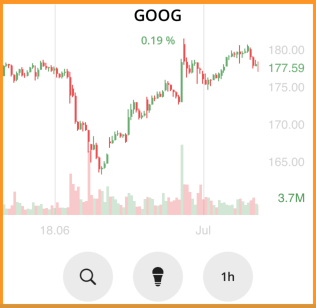Customizing ChartToolBar
The ChartToolBar component supports full customization. You can provide your own toolbar items, define custom actions, and set the data source and delegate. This guide shows how to add custom elements to the toolbar in a ChartScreen.
Basic concepts
- DataSource: Provides toolbar items (
ChartToolBar.Item). - Delegate: Handles toolbar events, such as slider updates.
- Custom Items: Define items with custom actions, icons, and behaviors.
Example: Custom toolbar handler

The example below shows how to implement a custom data source and delegate to define toolbar items and behavior:
import DXChartimport UIKitfinal class CustomToolbarHandler: DXChart.ChartToolBar.DataSource, ChartToolBar.Delegate {let dataProvider: DXChart.DataProvidervar chartViewController: ChartScreen.ViewController!init(dataProvider: DXChart.DataProvider) {self.dataProvider = dataProvider}func chartToolBarView(_ chartToolBarView: DXChart.ChartToolBar, updateValueFromSlider: Int) {print("Updated value \(updateValueFromSlider)")}var items: [DXChart.ChartToolBar.Item] {[.init(id: "Search",icon: UIImage(systemName: "magnifyingglass")!,action: { [weak self] _ inlet searchViewController = SearchInstrument.makeScreen(ipfDataProvider: dataProvider.ipfDataProvider,onChangeInstrument: { [weak self] newInstrument inguard let newInstrument else { return }self?.chartViewController.changeInstrument(newInstrument)})self?.chartViewController.present(searchViewController, animated: true)}),.init(id: "change theme",icon: UIImage(systemName: DXChartApp.settingsManager.settings.selectedTheme == .light ? "lightbulb.led" : "lightbulb.led.fill")!,action: { [weak self] _ inguard let self else { return }var settings = DXChartApp.settingsManager.settingssettings.selectedTheme = settings.selectedTheme == .light ? .dark : .lightself.chartViewController.updateSettings(settings)}),.init(id: "aggregation",actionType: .switcher,title: DXChartApp.dataStorage.aggregation.title,isSelected: chartViewController.state.isAggregationPickerShowing,action: { [weak self] isSelected inself?.chartViewController.updateAggregationPickerShowing(!chartViewController.state.isAggregationPickerShowing)}),]}}
Example: Filtering default toolbar items
You can access and modify the default toolbar items from the chart view controller. For example, to hide the first item (usually the search button):
// Assuming you have a reference to the chart view controllerlet defaultItems = chartViewController.defaultToolBarItemslet filteredItems = Array(defaultItems.dropFirst()) // hides the first item (e.g., search)// Or, to filter by id:let filteredById = defaultItems.filter { $0.id != "search" }
Use the filtered items in a custom data source:
var items: [DXChart.ChartToolBar.Item] {chartViewController.defaultToolBarItems.filter { $0.id != "search" }}
Integrating the custom toolbar in a ChartScreen
Pass your custom handler when creating the chart screen:
let customToolbarHandler = CustomToolbarHandler(dataProvider: dataProvider)let chartViewController = ChartScreen.makeScreen(dataProvider: dataProvider,delegate: quoteOperationsHandler,toolbarDataSource: customToolbarHandler,toolbarDelegate: customToolbarHandler,logoImage: nil,shouldShowLogo: false,shouldShowToolbar: true)customToolbarHandler.chartViewController = chartViewController
Tips
- Combine default and custom items to build a tailored toolbar.
- Use the
actionclosure inChartToolBar.Itemto handle tasks like presenting a screen, switching themes, or other actions. - To update the toolbar, modify the
itemsarray in your data source and callreload()on the toolbar.
Use this approach when your app needs precise control over the toolbar inside a ChartScreen.